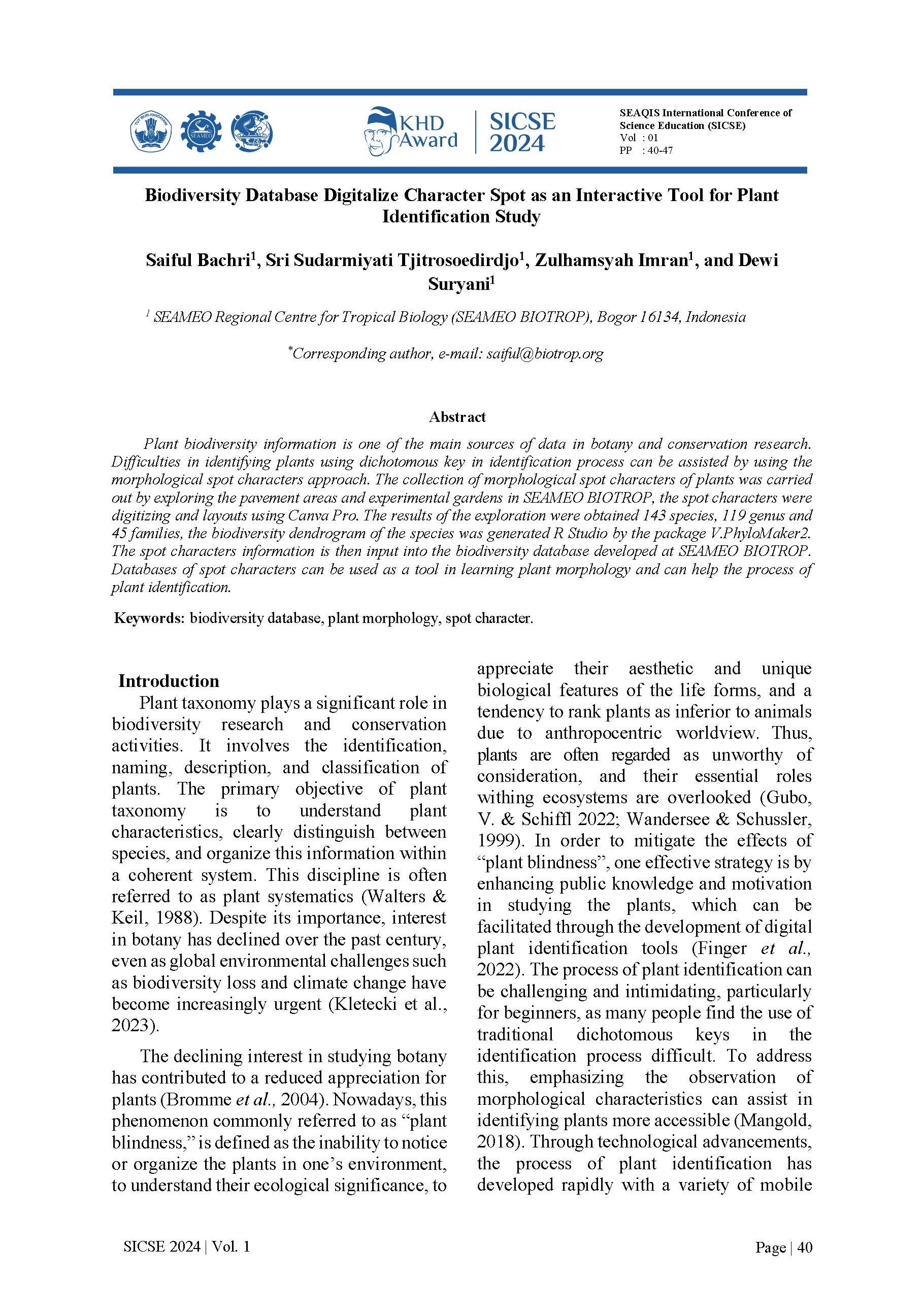Biodiversity Database Digitalize Character Spot as an Interactive Tool for Plant Identification Study
DOI:
https://doi.org/10.58249/mnfzxk62Keywords:
biodiversity database, plant morphology, spot characterAbstract
Plant biodiversity information is one of the main sources of data in botany and conservation research. Difficulties in identifying plants using dichotomous key in identification process, can be assisted by using the morphological spot characters approach. The collection of morphological spot characters of plants was carried out by exploring the pavement areas and experimental gardens in SEAMEO BIOTROP, the spot characters was digitizing and layouts using Canva Pro. The results of the exploration were obtained 143 species, 119 genus and 45 families, the biodiversity dendrogram of the species was generated R Studio by the package V.PhyloMaker2. The spot characters information is then input into the biodiversity database developed at SEAMEO BIOTROP. Database of Spot Characters can be used as a tool in learning of plant morphology and help the process of plant identification.
References
Balgooy, Max & Low, Yee Wen & Wong, K.M. (2015). Spot-characters for the Identification of Malesian Seed Plants: A Guide.
Bromme, R.; Stahl, E.; Bartholomé, T.; Pieschl, S. The Case of Plant Identification in Biology: When is a Rose a Rose. In Professional Learning: Gaps and Transitions on the Way from Novice to Expert; Boshuizen, P.P.A., Bromme, R., Gruber, H., Eds.; Kluwer Academic Press: Dordrecht, The Netherlands, 2004; pp. 53–71.
Finger, A.; Groß, J.; Zabel, J.Plant Identification in the 21st Century—What Possibilities Do Modern Identification Keys Offer for Biology Lessons? Educ. Sci. 2022, 12, 849. https://doi.org/10.3390/educsci12120849
Gubo, V. & Schiffl, S. (2022). The development of students’ interest in and knowledge of botany by means of a workshop on pollination and floral ecology. International Journal of Research in Education and Science (IJRES), 8(2), 262-273. https://doi.org/10.46328/ijres.2220 Hart, Adam & Bosley, Hayley & Hooper, Chloe & Perry, Jessica & Sellors‐Moore, Joel
& Moore, Oliver & Goodenough, Anne. (2023). Assessing the accuracy of free automated plant identification applications. People and Nature. 5. 10.1002/pan3.10460.
Irawan, B., & Eneng Nunuz Rohmatullayaly. (2023). The Jatinangoriense Herbarium as Learning Innovations within the Independent Learning Independent Campus (MBKM). Khizanah Al Hikmah: Jurnal Ilmu Perpustakaan, Informasi, Dan Kearsipan, 11(1). https://doi.org/10.24252/kah.v11i1.cf2
Jin, Yi & Qian, Hong. (2022). V.PhyloMaker2: An updated and enlarged R package that can generate very large phylogenies for vascular plants. Plant Diversity. 44. 10.1016/j.pld.2022.05.005.
Kexin, Dai & Buang, Nor. (2024). Integrating Innovative Teaching Strategies: Assessing the Effectiveness of Flipped Classrooms, Blended Learning, and Task-Oriented
Methods in Enhancing Academic Performance in Vocational IT Education. Journal of Digitainability, Realism & Mastery (DREAM). 3. 94-108. 10.56982/dream.v3i05.241.
Kletecki, N.; Hruševar, D.; Miti´c, B.; Šorgo, A. Plants Are Not Boring, School Botany Is. Educ. Sci. 2023, 13, 489. https://doi.org/10.3390/educsci13050489
Mangold, J. (2018). Plant Identification Basics. Bozeman, MT: Montana State University, Agriculture and Natural Resources (Weeds).
Nagabhushana, Dr & V, Dr & S, Nataraja. (2018). User Authentication Using Image Processing Techniques. International Journal of Advanced Networking Applications. 10. 3770- 3775. 10.35444/IJANA.2018.10023.
Singh, Utkarsh & Verma, Ashish & Kumar, Pradeep & Kaushik, Shivam & Kumar, Ashish. (2023). What is Weed, Classification, Characteristics and Different Methods of Weed Management.
Vega, Kevin & Schläpfer‐Miller, Juanita & Kueffer, Christoph. (2021). Discovering the wild side of urban plants through public engagement. Plants People Planet. 1-13. 10.1002/ppp3.10191.
Wäldchen, Jana & Wittich, Hans & Rzanny, Michael & Fritz, Alice & Mäder, Patrick. (2022). Towards more effective identification keys: A study of people identifying plant species characters. People and Nature. 4. 10.1002/pan3.10405.
Wandersee, J., & Schussler, E. (1999). Preventing Plant Blindness. The American BiologyTeacher, 61, 82-86. https://abt.ucpress.edu/content/61/2/82 https://doi.org/10.2307/4450624
Zungsontiporn, S., Sastroutomo, SS., Jongrukthai, T., Promma, A., and Noomde, M. 2020. Weeds and Weed Seeds of Southeast Asia with special focus on Thailand. ASEAN Network on Taxonomy (ASEANET), Serdang, Malaysia, 280pp.

Downloads
Published
Issue
Section
License
Copyright (c) 2025 SEAQIS International Conference on Science Education

This work is licensed under a Creative Commons Attribution 4.0 International License.
This work is licensed under a Creative Commons Attribution 4.0 International License.

